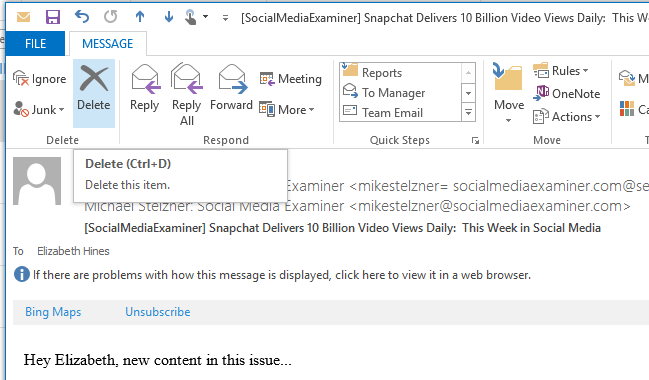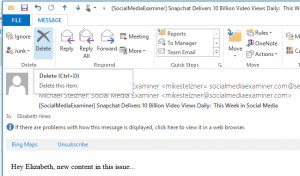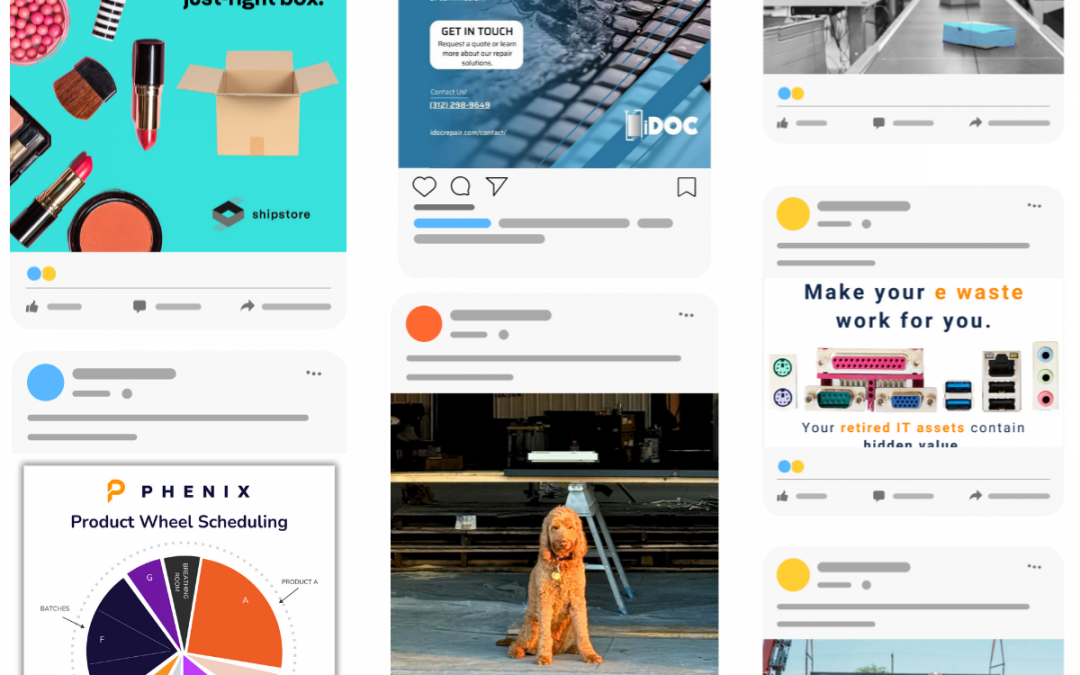
by Fronetics | Sep 21, 2016 | Blog, Content Marketing, Marketing, Strategy
To truly gauge the effect of variations in frequency of marketing emails, evaluate the cumulative metrics as well as per-message statistics.
How often does your company send marketing emails? Perhaps you’ve wondered if ramping up the number of messages you send to your database may generate more purchases. But you don’t want to cross the line of bothering people to the point where they unsubscribe or become annoyed with your business.
IBM Marketing Cloud recently released the 2016 Email Marketing Metrics Benchmark Study, which aggregates data from messages sent by nearly 750 companies representing 3,000 brands in 40 countries. It offers interesting insight on metrics like open rates, click-throughs, and mobile metrics.
Marketing emails and the frequency math effect
One key finding from this year’s study involves something called the “frequency math effect.” It first became evident for businesses in the retail and ecommerce sector during the holidays but applies across verticals.
During periods of heavy email volume, certain metrics that determine the effectiveness of marketing emails — i.e., opens and clicks per message — may drop off drastically. But this is not necessarily cause for panic. If you look over the entire sending period, you are likely to see the number of total opens and clicks go up.
Because your subscribers are receiving more emails from you, they tend to open fewer of those messages. But because you are touching your subscribers more often, engagement increases, likely dramatically. This could lead to more conversions and higher revenue.
But there’s more to consider here. List churn metrics — e.g., hard bounces, unsubscribe rates, spam complaints — are also subject to the frequency math effect.
When you are sending marketing emails more frequently, you’ll likely see a drop in your unsubscribe rates, reports of abuse, etc. But don’t celebrate too soon. Again, the cumulative number of these actions will increase.
To better gauge the impact of marketing email frequency, it’s important to look at both per-message statistics and total open, click-through, and list churn metrics for an entire period. By doing so, you’ll be able to more accurately determine whether a change in marketing email frequency has driven an overall net positive or negative impact.
Related posts:

by Fronetics | May 3, 2016 | Blog, Content Marketing, Marketing, Strategy

These tips will help you optimize your marketing emails to improve open rates.
Are you spending time creating marketing emails that nobody opens?
Today, everyone’s inbox is inundated with social media notifications, contests and giveaways, and marketing emails from every company they have even considered buying from in the last five years. How do you make your message stand out enough to not get deleted — let alone, read?
First and foremost, you must look at first-impression factors like subject lines, overall design, organization and formatting, and even when you are sending your emails.
For example, you may imagine potential customers sitting at their desks first thing each morning and going through emails, but that is not necessarily the case. Email marketing company Constant Contact finds that optimal open times vary widely by industry. But, truth be told, the best time for your business to send emails will be unique to your business — and the best way to know when is to test.
Another important factor to consider is how your potential customers are reading email. A recent Experian study found that 56% of email opens occur on a mobile device. If you send a marketing email that is not optimized for mobile, more than half of your recipients are straining and struggling to read your content. You’ve given them a good reason to delete it instead of reading it.
With these things in mind, how do you create marketing emails that potential customers will actually open and read? Here are a few basics:
Optimize what the recipient first sees.
Your sender name should be easily identifiable as coming from you, as this will influence if your reader opens your message.
Convey your point in the subject line.
Your subject line is the first thing your readers see and a major determinant in whether the recipient will open your email or hit delete. It should be short (under 70 characters so it does not get cut off), catchy, and attention-grabbing, but also to-the-point. Recipients should understand what the email is about without even opening it, but the subject line should hook them into wanting to know more.
Create a sense of urgency.
Give customers a reason to act quickly, rather than let the email sit in their inbox. Craft this sense of urgency within your subject line with some form of time limit or “what-you-must-know-now” phrasing.
Avoid words that label your email as spam.
Always avoid using words like “Cash,” “Quote,” and “Save.” Filters are designed to move emails with these words into spam.
Make it personal.
If the recipient is someone with whom you have done business or a potential customer that has signed up for newsletters or promotions, make it personal. Including their name makes the email feel conversational and almost rude if they don’t open it and at least see what you have to say to them. Studies show that personalized email subject lines increase open rates across industries by as much as 40%.
Certainly, open rates are not the only measure of success when it comes to marketing emails. But, to achieve your goals, it is vital to optimize the number of people who actually read your marketing message. Simply put, you cannot reach your audience unless you garner their interest quickly and get them to open up your message.
Related posts:

by Jennifer Hart Yim | Dec 12, 2024 | Marketing
Trade show marketing has become a cornerstone strategy for logistics companies seeking to expand their market presence. In this guide, we’ll explore how to maximize your logistics trade show marketing investment and generate qualified leads that convert.
Major logistics trade shows like MODEX and ProMat serve as crucial networking hubs for supply chain pros. A well-executed trade show strategy can generate 200-300 qualified leads per event, making it one of the most effective marketing channels for logistics providers. Here’s how you can make your next show the best yet.
Creating Your Logistics Trade Show Marketing Strategy
Pre-Show Preparation
Success in logistics trade show marketing isn’t about luck – it’s about meticulous planning and execution. The most successful companies typically begin their preparation three to six months before the event, ensuring every detail is carefully considered. Here are 3 ways to do that.
- Set measurable goals: Target specific metrics such as “schedule 30 qualified demos” or “secure 5 partnership meetings with retailers”
- Create a pre-show marketing calendar:
- Send personalized invitations to top prospects 6 weeks before the event
- Launch a LinkedIn campaign highlighting your booth location and key offerings 4 weeks out
- Schedule social media posts featuring behind-the-scenes preparation 2 weeks prior
- Develop a clear ROI framework: Calculate your cost per lead target based on total exhibition costs (typically $10,000-30,000 for mid-sized shows)
Stand Design and Presence
Your booth is more than just a space – it’s a statement about your company’s capabilities and vision for the future of logistics. The most memorable booths tell a story through their design and interactive elements, creating an immersive experience that draws visitors in and keeps them engaged.
Transform your booth into an experience center by including:
- Live demonstrations of your TMS or WMS
- Digital walls displaying real-time shipment tracking across global routes
- Interactive supply chain optimization simulators
- Climate-controlled storage solution demonstrations
- Video testimonials from current clients running on loop
Maximizing Your Trade Show Investment
The key to maximizing your trade show ROI lies in the delicate balance between attracting quantity and qualifying quality. While it’s tempting to collect as many business cards as possible, successful logistics companies focus on meaningful conversations that uncover genuine opportunities.
Lead Generation Tactics
Modern lead generation at logistics trade shows has evolved far beyond the traditional business card exchange. Successful exhibitors use a sophisticated blend of technology and personal interaction to identify and nurture potential clients. Maximize your time and effort in connecting with prospects by using this strategy.
- Create tiered lead scoring systems:
- Hot leads: Decision-makers with immediate needs (follow up within 24 hours)
- Warm leads: Prospects planning changes within 6 months
- Long-term prospects: Companies researching options for future consideration
- Offer exclusive trade show incentives like:
- 90-day free trial of your logistics software
- Complimentary supply chain audit
- Special pricing for contracts signed within 30 days post-show
Technology Integration
Technology isn’t just part of your service offering – it’s an essential tool for engaging prospects at trade shows. The right technology can help you demonstrate complex logistics solutions in simple, memorable ways (and make your life easier!).
- Deploy AR (Augmented Reality) demonstrations showing:
- Warehouse optimization solutions
- Cross-docking procedures
- Last-mile delivery innovations
- Use RFID-enabled badges to track booth visitor engagement (See? Makes life easier!)
- Implement AI-powered chatbots for initial visitor screening
Post-Show Success Strategies
The days immediately following a trade show are crucial for converting interest into actual business opportunities. The most successful logistics companies understand that prompt, personalized follow-up is essential for maintaining the momentum generated during the show.
Create a structured follow-up system:
- Day 1-2: Send personalized thank you emails with specific reference to conversations
- Day 3-5: Share relevant case studies based on discussed pain points
- Week 2: Schedule virtual demos or consultation calls
- Week 3-4: Present customized solutions and proposals
- Month 2: Check in with prospects who showed interest but weren’t ready to commit
Calculate Logistics Trade Show ROI
Understanding the return on investment from logistics trade show marketing requires a comprehensive approach. While traditional metrics like booth traffic provide basic insights, it’s the deeper dive into performance indicators that truly matter.
Cost Per Lead
This serves as a fundamental benchmark in the logistics industry. With the average cost ranging from $150-275 per qualified lead, companies must carefully balance their exhibition investment against potential returns. This metric becomes particularly crucial when comparing different trade shows or deciding which events deserve larger budget allocations.
Conversion Rates
They tell an even more compelling story. The industry target of 20-30% reflects the high-quality nature of trade show leads compared to other marketing channels. Successful logistics companies achieve these rates by focusing on meaningful conversations rather than collecting business cards. For instance, a company demonstrating its warehouse automation solution might connect with fewer prospects but secure more serious buyers.
Six-month Revenue Generation
Perhaps the clearest picture of trade show success. By tracking deals that close within this window, companies can attribute revenue directly to their trade show efforts. This longer-term view acknowledges the complex sales cycles common in logistics partnerships, where decisions often involve multiple stakeholders and careful evaluation periods.
Social Engagement Metrics
Social metrics have emerged as a valuable supplement to traditional measurements. Beyond simple follower counts, companies track event hashtag usage, LinkedIn post engagement, and video view duration to gauge their brand’s impact during and after the show.
Successful logistics trade show marketing requires a delicate balance of traditional networking and strategic digital follow-up. Those that invest in comprehensive pre-show planning, engage audiences with interactive demos, and maintain consistent post-show communication will stand out. As we move forward, the integration of virtual elements, sustainability practices, and AI-driven engagement tools will continue to reshape how logistics companies approach trade shows. However, the fundamental goal remains unchanged: creating meaningful connections that drive business growth. By implementing the strategies outlined in this guide, logistics companies can transform their trade show presence from a simple marketing expense into a powerful engine for lead generation and business development.
Read more

by Elizabeth Hines | Sep 6, 2024
Supply Chain Marketing Services Bold campaigns that deliver results From brand development projects to social media management and everything in between, our supply chain marketing services cover it all. Our tailored strategies ensure you get everything you need and...

by Elizabeth Hines | Sep 4, 2024
Supply chain marketing examples We turn bright ideas into powerful deliverables We don't just promise the moon to our supply chain clients — we deliver it. Peek behind the curtain at some of our work. Spoiler alert: We crushed it. Let's work together OUR WORK B2B...






